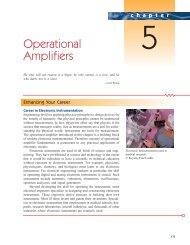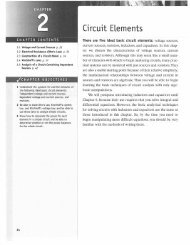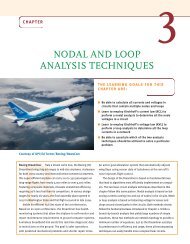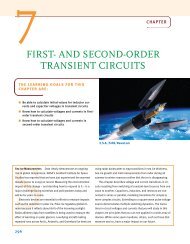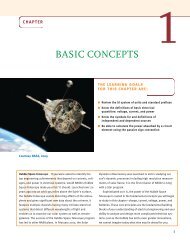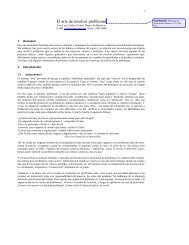Fundamentals of Electric Circuits
Fundamentals of Electric Circuits
Fundamentals of Electric Circuits
You also want an ePaper? Increase the reach of your titles
YUMPU automatically turns print PDFs into web optimized ePapers that Google loves.
3.6 Nodal and Mesh Analyses by Inspection 101<br />
or simply<br />
Gv i<br />
(3.23)<br />
where<br />
G kk Sum <strong>of</strong> the conductances connected to node k<br />
G k j G jk Negative <strong>of</strong> the sum <strong>of</strong> the conductances directly<br />
connecting nodes k and j, k j<br />
v k Unknown voltage at node k<br />
i k Sum <strong>of</strong> all independent current sources directly connected<br />
to node k, with currents entering the node treated as positive<br />
G is called the conductance matrix; v is the output vector; and i is the<br />
input vector. Equation (3.22) can be solved to obtain the unknown node<br />
voltages. Keep in mind that this is valid for circuits with only independent<br />
current sources and linear resistors.<br />
Similarly, we can obtain mesh-current equations by inspection<br />
when a linear resistive circuit has only independent voltage sources.<br />
Consider the circuit in Fig. 3.17, shown again in Fig. 3.26(b) for convenience.<br />
The circuit has two nonreference nodes and the node equations<br />
were derived in Section 3.4 as<br />
v 1<br />
c R 1 R 3 R 3<br />
d c i 1<br />
d c d<br />
R 3 R 2 R 3 i 2 v 2<br />
(3.24)<br />
We notice that each <strong>of</strong> the diagonal terms is the sum <strong>of</strong> the resistances<br />
in the related mesh, while each <strong>of</strong> the <strong>of</strong>f-diagonal terms is the negative<br />
<strong>of</strong> the resistance common to meshes 1 and 2. Each term on the<br />
right-hand side <strong>of</strong> Eq. (3.24) is the algebraic sum taken clockwise <strong>of</strong><br />
all independent voltage sources in the related mesh.<br />
In general, if the circuit has N meshes, the mesh-current equations<br />
can be expressed in terms <strong>of</strong> the resistances as<br />
≥<br />
R 11 R 12 p R 1N<br />
R 21 R 22 p R 2N<br />
¥ ≥<br />
o o o o<br />
R N1 R N2 p R NN<br />
i 1<br />
v 1<br />
i 2 v 2<br />
¥ ≥ ¥<br />
o o<br />
i N v N<br />
(3.25)<br />
or simply<br />
Ri v<br />
(3.26)<br />
where<br />
R kk Sum <strong>of</strong> the resistances in mesh k<br />
R kj R jk Negative <strong>of</strong> the sum <strong>of</strong> the resistances in common<br />
with meshes k and j, k j<br />
i k Unknown mesh current for mesh k in the clockwise direction<br />
v k Sum taken clockwise <strong>of</strong> all independent voltage sources in<br />
mesh k, with voltage rise treated as positive<br />
R is called the resistance matrix; i is the output vector; and v is<br />
the input vector. We can solve Eq. (3.25) to obtain the unknown mesh<br />
currents.




